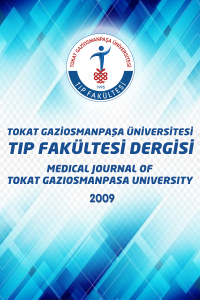Travmatik Diz Çıkığında Multipl Primer Bağ Onarımı: Olgu Sunumu
Diz çıkığı, multipl ligamant rüptürü, primer onarım
Primary Multiple Ligament Repair in Traumatic Knee Dislocation: Case Report
Knee dislocation, multiple ligament rupture, primary repair,
___
- 1. Harner Christopher D. et al. "Surgical management of knee dislocations." J Bone Joint Surg Am.2004:86;2:262-273.
- 2. Liow RYL., et al. "Ligament repair and reconstruction in traumatic dislocation of the knee." Bone & Joint Journal.2003: 85:6:845-851.
- 3. Girgis FG, Marshall JL, Monajem A. The cruciate ligaments of the knee joint. Anatomical, functional and experimental analysis. Clin Orthop. 1975;106:216-31.
- 4. Seroyer ST, Musahl V, Harner CD. Management of the acute knee dislocation: The Pittsburgh experience. Injury. 2008 Jul. 39(7):710-8
- 5. Kennedy JC. Complete Dislocation of the Knee Joint. J Bone Joint Surg. 1963;45(5):889-904.
- 6. Thomsen PB, Rud B, Jensen UH. Stability and motion after traumatic dislocation of the knee. Acta Orthop Scand. 1984;55(3):278-83
- 7. Hughston JC, Jacobson KE. Chronic posterolateral rotatory instability of the knee. J Bone Joint Surg Am. 1985;67(3):351-9.
- 8. Bin SI, Nam TS. Surgical outcome of 2-stage management of multiple knee ligament injuries after knee dislocation. Arthroscopy. 2007;23(10):1066-72.
- 9. Hollis, Jeffrey D, and Brian J. Daley. "10-year review of knee dislocations: is arteriography always necessary?." Journal of Trauma and Acute Care Surgery. 2005:59:3:672-676.
- 10. Stannard, James P. et al. "Vascular injuries in knee dislocations: the role of physical examination in determining the need for arteriography." J Bone Joint Surg Am. 2004;86:5:910-915.
- 11. Niall D. Nutton MRW, and Keating JF. "Palsy of the common peroneal nerve after traumatic dislocation of the knee." Bone & Joint Journal. 2005;87:5:664-667.
- 12. Richter M, et al. "Comparison of surgical repair or reconstruction of the cruciate ligaments versus nonsurgical treatment in patients with traumatic knee dislocations." The American Journal of Sports Medicine. 2002;30:5:718-727.
- 13. Dedmond, Barnaby T., and Louis C. Almekinders. "Operative versus nonoperative treatment of knee dislocations: a meta-analysis." The American Journal of Knee Surgery. 2000;14:1:33-38.
- 14. Tzurbakis M. et al. "Surgical treatment of multiple knee ligament injuries in 44 patients: 2–8 years follow-up results." Knee Surgery, Sports Traumatology, Arthroscopy. 2006;14:8:739-749.
- 15. Owens Brett D. et al. "Primary repair of knee dislocations: results in 25 patients (28 knees) at a mean follow-up of four years." Journal of Orthopaedic Trauma. 2007;21:2:92.
- 16. Stannard James P, et al. "The posterolateral corner of the knee repair versus reconstruction." The American Journal of Sports Medicine. 2005;33:6:881-888.
- 17. Twaddle, Bruce C., Terri A. Bidwell, and Jens R. Chapman. "Knee dislocations: where are the lesions? a prospective evaluation of surgical findings in 63 cases." Journal of Orthopaedic Trauma. 2003:198-202.
- ISSN: 1309-3320
- Başlangıç: 2009
- Yayıncı: Tokat Gaziosmanpaşa Üniversitesi
Kronik Hepatit B Hastalarının Tedavi Sonuçlarının Değerlendirilmesi
Cihan UÇAR, Bora BOSTAN, Orhan BALTA, Murat AŞÇI, Erkal BİLGİÇ, Taner GÜNEŞ
İlçe Hastanesinde Lokal Anestezi ile Cerrahi Deneyimimiz
Travmatik Diz Çıkığında Multipl Primer Bağ Onarımı: Olgu Sunumu
Orhan BALTA, Murat AŞCI, Harun ALTINAYAK, Bora BOSTAN
İn Vitro Fertilizasyon (İVF) Sikluslarında Long Luteal Agonist Tedavisi
Bülent ÇAKMAK, Mehmet Can NACAR
Yutma Güçlüğü ve Boğaz Ağrısı ile Gelen Hastada Servikal Disk Protezinin Anterior Dislokasyonu
